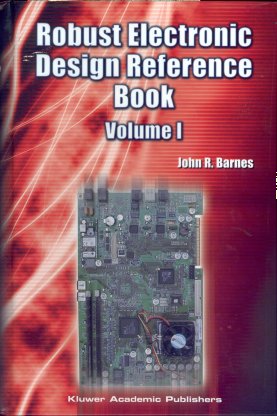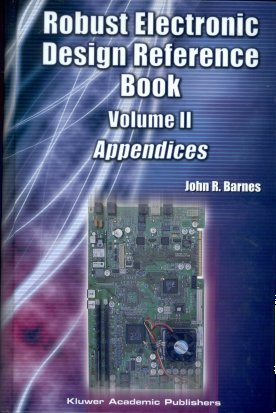�
Robust Electronic Design Reference Book
Volumes I and II
This web site is being maintained by John R. Barnes, who was the President
and Chief Engineer of dBi Corporation from 2002 to September 30, 2013,
when we closed because ObamaCrap made it too expensive for us to remain in
business.
ISBN 1-4020-7739-4, Kluwer Academic Publishers, 2004, $430.00 (US)
John R. Barnes KS4GL, PE, NCE, NCT, ESDC Eng, ESDC Tech, PSE, Master EMC
Design Engineer, SM IEEE
December 19, 2010
jrbarnes@iglou.com



To read a sample chapter, please go to
Chapter 17. To date readers and I have found 16 errors in the two
volumes. These errors, and corrections to them, are available at
http://www.r-e-d-inc.com/errata.htm
My first book, Electronic System Design: Interference and Noise Control
Techniques, focused on designing electronics to meet design
specifications. It was published in English (Prentice-Hall, 1987, ISBN
0-13-252123-7) and Russian (Mir Publishers, 1990, ISBN 5-03-001369-5).
With 15 chapters, 9 appendices, 16 tables, and 120 figures in 234 pages,
Electronic System Design had approximately:
- 12 pages on selecting passive components.
- 6 pages on selecting active components.
- 36 pages on circuit design.
- 101 pages on wiring and physical design.
- 4 pages on testing and debugging prototype units.
- 26 bibliographic references.
- 1,100 search terms in the index.
My second and third books,
Robust Electronic
Design Reference Book, Volumes I and II, which were released by
Kluwer Academic Publishers on March 24,
2004, are much more ambitious. I have tried to cover every aspect of
successfully developing electronic products and equipment, starting from a
fuzzy idea or need, and with a minimum of time/ money/ wasted effort/ angst
getting to:
- An electronic product in mass production and on the market.
- One or more pieces of electronic equipment in service, helping your
company/ organization produce or develop products, or providing services
to your customers.
These books assume that you know enough electronics to design circuits and
make them work (at least somewhat and sometimes) in your own lab. If you are
studying electronics in college, these books probably won't help you much
until at least your senior year. But from that point on in your studies and
career, these books will take you from how how electronic components and
circuits are supposed to work to how they actually do work--and
help you develop a deep understanding of electronics so that your
designs will meet all of their requirements through:
- Careful circuit design.
- Wise choice of components.
- Proper physical design and layout.
- Thorough testing and characterization of subsystems and the completed
unit(s).
Following the guidelines and applying the information provided in these books,
you can ensure that your designs:
- Work.
- Are safe and reliable.
- Can be manufactured, tested, repaired, and serviced economically.
- May be marketed and used worldwide.
- Can be easily adapted/ enhanced to meet new and changing market
requirements.
With 46 chapters, 21 appendices, 194 tables, and 663 figures in 1,736 pages,
Robust Electronic Design Reference Book, Volumes I and II have
approximately:
- 48 pages on developing design specifications.
- 244 pages on selecting passive components.
- 222 pages on selecting active components.
- 169 pages on circuit design.
- 491 pages on wiring and physical design.
- 101 pages on debugging, testing, qualifying, and approving prototype
units.
- 1,900 bibliographic references.
- 8,000 search terms in the indexes.
Robust Electronic Design Reference Book, Volume I covers:
- Chapter 1: Introduction to Robust Electronic Design
- Chapter 2: Preparation for Robust Electronic Design
- Chapter 3: Developing Products and Equipment Using Robust Electronic
Design
- Chapter 4: Noise Sources, Noise Coupling Paths, and Noise Victims
- Chapter 5: Selecting Passive Components
- Chapter 6: Resistors
- Chapter 7: Fuses
- Chapter 8: Capacitors
- Chapter 9: Inductors and Transformers
- Chapter 10: EMC Ferrites
- Chapter 11: Crystals and Ceramic Resonators
- Chapter 12: Switches, Controls, Indicators, Displays, and Relays
- Chapter 13: Batteries, Fuel Cells, and Solar Cells
- Chapter 14: Connectors and Sockets
- Chapter 15: Selecting Active Components
- Chapter 16: Diodes
- Chapter 17: Transient Suppressors and Surge Suppressors
- Chapter 18: Transistors, FET's, and Thyristors
- Chapter 19: Optoelectronics
- Chapter 20: Integrated Circuits
- Chapter 21: Designing Digital Circuits
- Chapter 22: Designing Analog Circuits
- Chapter 23: Designing Interface Circuits
- Chapter 24: Designing Power Supply Circuits
- Chapter 25: Designing Microprocessor and Microcontroller Circuits
- Chapter 26: Partitioning
- Chapter 27: Grounds and Returns
- Chapter 28: Bypassing, Decoupling, and Power Distribution
- Chapter 29: Wires, Traces, and Planes
- Chapter 30: Transmission Lines
- Chapter 31: Designing Printed Circuit Boards
- Chapter 32: Designing Cables and Backplanes
- Chapter 33: Bonding
- Chapter 34: Shielding
- Chapter 35: Filtering
- Chapter 36: Enclosures and Mechanical Design
- Chapter 37: Software
- Chapter 38: Watchdog Timers
- Chapter 39: Thermal Considerations
- Chapter 40: Finding and Fixing Problems
- Chapter 41: Desk Checks
- Chapter 42: Lab Tests
- Chapter 43: ESD Testing
- Chapter 44: Approval Testing
- Chapter 45: EMC/EMI/ESD and Safety
- Chapter 46: Some Parting Thoughts
- Acronyms and Common/Trade Names
- Bibliography
- Conversion Factors
- Glossary
- Schematic Symbols
- Definitions of Units and Symbols
- Index, Volumes I and II
Robust Electronic Design Reference Book, Volume II covers:
- Appendix A: A Refresher on Circuit Analysis
- Appendix B: Taylor Worst-Case Design
- Appendix C: Important Properties of Conductors and Ferrites
- Appendix D: Important Properties of Insulators and Semiconductors
- Appendix E: Galvanic and Triboelectric Series
- Appendix F: Important Properties of Wires and Cables
- Appendix G: Important Properties of Printed Circuit Boards, Hybrid
Modules, Flat Cables, and Busbars
- Appendix H: Wire Gages
- Appendix I: Sheet Metal Gages
- Appendix J: Bergeron Diagrams
- Appendix K: Electromagnetic Field Theory
- Appendix L: International Power, Plugs, and Languages
- Appendix M: International Safety Requirements
- Appendix N: International EMC/EMI/ESD Requirements
- Appendix O: Miscellaneous International Requirements
- Appendix P: Finding and Buying Standards
- Appendix Q: Glossary
- Appendix R: Acronyms and Common/Trade Names
- Appendix S: Definitions of Units and Symbols
- Appendix T: Conversion Factors
- Appendix U: Schematic Symbols
- Index, Volume II:
Kluwer merged with Springer in July 2004. For further information on
Robust Electronic Design Reference Book, Volumes I and II (ISBN
1-4020-7739-4), please also see:
To buy copies directly from the publisher, you can:
- Order them online at
http://www.springeronline.com/sgw/cda/frontpage/0,11855,4-40109-22-33340417-0,00.html
- For North America, Central America, and South America, order them by
mail, phone, or fax from Springer, 233 Spring Street, New York, NY
10013 USA; phone (212)460-1500 or 800-SPRINGER (weekdays 8:30am-5:30pm
Eastern Time); fax (212)460-1575; or E-mail
service@springer-ny.com.
- For all other countries, order them by mail, phone, or fax from
Kluwer Academic Publishers Group, Post Office Box 322, 3300 AH
Dordrecht, THE NETHERLANDS, phone (31 78 6576 000), fax (31 78 6576 254).
Richard Georgerian and Gary Steinkogler E-mailed me that the a number of
online book sellers are also selling Robust Electronic Design Reference
Book, Volumes I and II (ISBN 1-4020-7739-4), many of them at a discount
from the list price of $430.00 per set. As of December 19, 2010 these included:
If you see my book offered at a price that looks too good to be true, please
check the ISBN. The set of Volumes I and II is ISBN 1-4020-7739-4. Volume I
alone is ISBN 1-4020-7737-8. Volume II alone is ISBN 1-4020-7738-6. We broke
the book into two volumes because some of the people who browsed through the
manuscript at the IEEE EMC Symposium in Boston in 2003 said that
they weren't electronic engineers, but they could really use the
information in the appendices. By offering the appendices as a second book,
Alex Greene (my Editor) felt that we could increase the market for the
book(s), and I agreed. I included the Acronyms and Common/Trade Names,
Conversion Factors, Glossary, Schematic Symbols, and Definitions of Units and
Symbols sections in Volume I, even though they were already in the Appendices,
so that Volume I would be self-contained. But if you are doing electronics
design, I believe that you will use both volumes.
If you run across other sources, please E-mail me the URL at
jrbarnes@iglou.com so that we can
share this information with other prospective users/ buyers of the books.
Thanks!
If you run into an error in either book, please check
http://www.r-e-d-inc.com/errata.htm to see if I have posted a correction.
If I haven't, please E-mail me at
jrbarnes@iglou.com with:
- The page number(s).
- A description of my error.
- What you think the text/ table/ figure should say.
- For technical errors, the reference(s) that you used--with page numbers
--so that I can verify your information.
- Your name, so that I can acknowledge your help, on that web page.
dBi Corporation was a
one-man test house (testing laboratory) based in Lexington, Kentucky, testing
a wide variety of commercial electronic products for electromagnetic
compatibility (EMC), electromagnetic interference (EMI), and electrostatic
discharge (ESD) under its ISO 17025 accreditation. dBi was founded in
Winchester, Kentucky in 1995 by Donald R. Bush, shortly after he retired from
30 years service with IBM Lexington's/ Lexmark's EMC Lab. John R. Barnes,
who'd worked with Don at IBM Lexington and Lexmark, bought dBi in 2002
after Don's death, and moved the company to Lexington, Kentucky. John closed
dBi at 11:59pm EDT on September 30, 2013, because ObamaCrap had
increased operating expenses to the point that we could no longer afford to
remain in business.
We'd like to thank all of the clients who chose dBi to test their
products from 1995 to 2013. Below is a brief summary of our accomplishments
during the 18 years we were in business.
From 1995 to 2001, under Don Bush's ownership and operation, dBi:
- Did the official approval testing of 141 products developed by 20
client companies.
- Did the official FCC/ Industry Canada (IC) Verification and Declaration
of Conformity (DoC) testing of 92 products.
- Did the official FCC/IC Certification testing of 15 products.
- Did the official CE Marking testing of 100 products.
From 2002 to 2013, under John Barnes' ownership and operation, dBi:
- Tested 389 products and 2 testers developed by 44 client companies.
- Did the official approval testing of 357 products and 2 testers, getting
all but 5 of them to meet all of the FCC, Industry Canada
(IC), CE Marking, C-Tick, and Regulatory Compliance Mark (RCM) standards
and requirements for their desired market areas.
- Did the official FCC/IC Verification and Declaration of Conformity (DoC)
testing of 296 products.
- Did the official FCC/IC Certification testing of 24 products.
- Did the official CE Marking testing of 271 products and 2 testers.
- Did the official e-Mark testing of 3 products.
- Did the official Australia/New Zealand Verification testing of 170
products.
- Co-sponsored John's writing the
Robust Electronic Design Reference Book,
Volumes I and II.
- Served as an expert witness on electronics in three lawsuits.
Last revised December 19, 2010.



